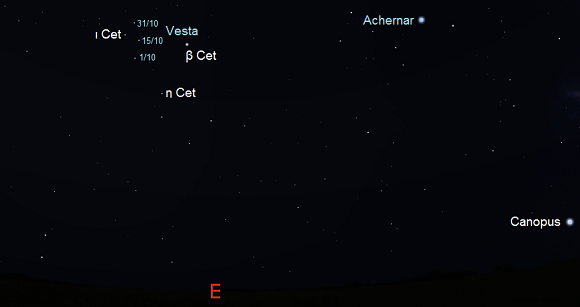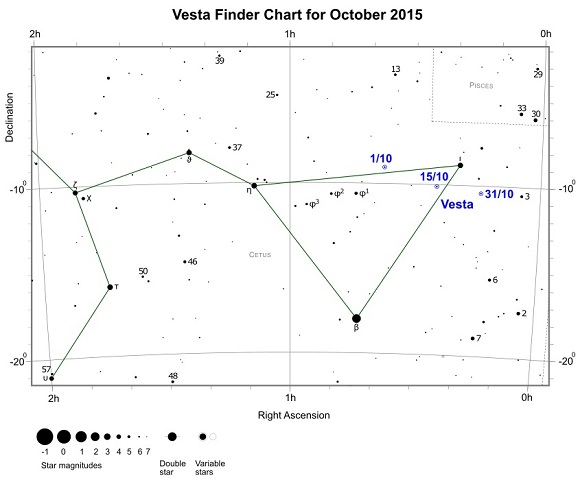Vesta the brightest asteroid has just passed opposition (Sep 29th) and remains bright enough during October to be easily seen with binoculars or small scopes. The asteroid is visible as soon as it's dark enough and remains so for most of the night as it moves retrograde among the stars of western Cetus. At favourable oppositions Vesta can even be glimpsed with the naked eye but on this occasion it didn't quite reach that, peaking at mag. +6.2

Discovery
Vesta was the fourth asteroid to be discovered on March 29, 1807 by German astronomer Heinrich Wilhelm Olbers. Although it's the third largest body in the main asteroid belt after Ceres and Pallas it appears the brightest due to its more reflective surface and closer approach's to Earth.
Location
During October, Vesta appears above the southeast / east horizon in early evening. It cuts through the inside corner of a triangle of stars consisting of iota Cet (ι Cet - mag. +3.6), beta Cet (β Cet - mag. +2.0) and eta Cet (η Cet - mag +3.5) as the month progresses. Of the three stars the asteroid is positioned closest to ι Cet passing less than 2 degrees south of it around the middle of the month.
The star charts below show the location of Vesta. Throughout October it remains easily visible with binoculars despite dimming from mag. +6.2 to +6.8.



Finder chart for Vesta during October 2015 - pdf format (credit:- freestarcharts)
Vesta Data Table - October 2015
| Date | RA (J2000) | DEC (J2000) | Apparent Magnitude | Constellation |
|---|---|---|---|---|
| Oct 01 | 00h 37m 27s | -09d 02m 26s | 6.2 | Cetus |
| Oct 02 | 00h 36m 31s | -09d 08m 15s | 6.2 | Cetus |
| Oct 03 | 00h 35m 35s | -09d 13m 53s | 6.3 | Cetus |
| Oct 04 | 00h 34m 39s | -09d 19m 22s | 6.3 | Cetus |
| Oct 05 | 00h 33m 43s | -09d 24m 40s | 6.3 | Cetus |
| Oct 06 | 00h 32m 48s | -09d 29m 47s | 6.3 | Cetus |
| Oct 07 | 00h 31m 53s | -09d 34m 42s | 6.3 | Cetus |
| Oct 08 | 00h 30m 59s | -09d 39m 25s | 6.3 | Cetus |
| Oct 09 | 00h 30m 04s | -09d 43m 57s | 6.4 | Cetus |
| Oct 10 | 00h 29m 11s | -09d 48m 15s | 6.4 | Cetus |
| Oct 11 | 00h 28m 18s | -09d 52m 22s | 6.4 | Cetus |
| Oct 12 | 00h 27m 26s | -09d 56m 15s | 6.4 | Cetus |
| Oct 13 | 00h 26m 34s | -09d 59m 54s | 6.4 | Cetus |
| Oct 14 | 00h 25m 43s | -10d 03m 21s | 6.5 | Cetus |
| Oct 15 | 00h 24m 54s | -10d 06m 34s | 6.5 | Cetus |
| Oct 16 | 00h 24m 05s | -10d 09m 32s | 6.5 | Cetus |
| Oct 17 | 00h 23m 17s | -10d 12m 17s | 6.5 | Cetus |
| Oct 18 | 00h 22m 30s | -10d 14m 48s | 6.5 | Cetus |
| Oct 19 | 00h 21m 44s | -10d 17m 05s | 6.6 | Cetus |
| Oct 20 | 00h 20m 60s | -10d 19m 07s | 6.6 | Cetus |
| Oct 21 | 00h 20m 16s | -10d 20m 55s | 6.6 | Cetus |
| Oct 22 | 00h 19m 34s | -10d 22m 29s | 6.6 | Cetus |
| Oct 23 | 00h 18m 54s | -10d 23m 49s | 6.6 | Cetus |
| Oct 24 | 00h 18m 14s | -10d 24m 54s | 6.7 | Cetus |
| Oct 25 | 00h 17m 36s | -10d 25m 45s | 6.7 | Cetus |
| Oct 26 | 00h 16m 59s | -10d 26m 22s | 6.7 | Cetus |
| Oct 27 | 00h 16m 24s | -10d 26m 45s | 6.7 | Cetus |
| Oct 28 | 00h 15m 50s | -10d 26m 54s | 6.8 | Cetus |
| Oct 29 | 00h 15m 18s | -10d 26m 49s | 6.8 | Cetus |
| Oct 30 | 00h 14m 47s | -10d 26m 30s | 6.8 | Cetus |
| Oct 31 | 00h 14m 17s | -10d 25m 57s | 6.8 | Cetus |